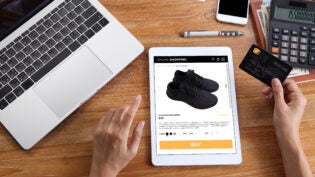
With today’s economy and our lifestyles seeming to revolve around mobile technology, there appears to be a never-ending race to devise and create the “next big thing.” And more often than not, that tends to be a mobile app.
It’s certainly not easy to come up with a unique and innovative idea with all the new mobile apps flooding the App Store on a daily basis. And having an idea is unfortunately just the beginning. The process of creating a mobile app can be incredibly arduous and frustrating, but this step-by-step guide will facilitate the process for all entrepreneurs looking to get started.
1. Focus the App and Its Business Model
So you have an idea. It’s tempting to get started as quickly as possible on making your mobile app, but it’s important to remain patient. You must first have a clear definition of what your app’s business model will be. A platform business model is your best bet. Uber, Airbnb, Snapchat, YouTube and countless other unicorns are all platforms.
Next is detailing what your app’s core interaction will be and what value it will deliver to users. A vague idea will get you nowhere. If your description of the core interaction requires you to use “and” a lot, chances are you’re stretching yourself too thin and your platform lacks focus.
Uber connected drivers with riders. Airbnb connected renters with holders of spare lodging inventory. Instagram made social sharing of beautiful pictures easy and fast. These platforms did one thing well and focused on getting initial traction around their core interaction before trying to facilitate other interactions.
Remember, there is always the possibility of adding more features in V2. Investors want traction and if you inundate your target users with too many options, you’ll never make it out the gate. It’s also very expensive to add features. Startups must be scrappy and smart with their resources. Focus your app’s resources in areas that will deliver the greatest interaction to achieve network effects and build those out first.
2. Know Thy Competition
Once you have a firm grasp on your mobile app’s core interaction, it’s time to start researching.
The first thing to consider is your competition. You must consider not only the number of competitors in a certain market, but also the success those competitors have had. It’s definitely risky to enter a heavily saturated market, but competition indicates a ripe market and great opportunity. However, if several competitors have already raised dozens of millions of dollars in series B or C funding, then you should be asking yourself what your mobile app’s differentiation is and whether or not it will be strong enough to compensate for your late entry.
On the other hand, if a market is wide open, it’s important to understand why that’s the case and reevaluate whether or not your idea is a good one. If it were a good idea, wouldn’t you expect to see some level of competition already in place?
For more in-depth perspective, refer to a Huffington Post article I wrote on scoping out your app’s competition.
3. Plan and Validate
Once you’ve focused your mobile app idea and have conducted your research, then it’s time to start laying out the plan for your mobile app. This is where your idea starts becoming a tangible product. For starters, it’s important to understand the difference between UI and UX. UX is concentrated on designing for the user’s needs and understanding necessary tasks involved in using a product/service to accomplish a goal. UI is more focused on the usability of an interface, determined by its ease, efficiency, and enjoyment of use.
Related Article: What Should My Business’s Mobile App Include?
You should focus on UI to start. Think about what screens your app will have, what their functions will be and how they are going to be interconnected. UX is less of a concern because it’s more cosmetic, but it always helps to have a vision for what your app’s design principles should be. You might even want to consider creating a detailed plan for your platform with wireframes and even a clickable prototype.
Once your documents are ready, it’s time to share them with people, asking for honest feedback. Then tailor your roadmap and UI/UX plans to their suggestions. When you’ve completed planning the layout for your app, you must consider which mobile OS platform you would like your app to be on. Always go iOS first when developing an app. Plain and simple. If you want your app to be on both the Android and iOS markets, be aware that Android apps are more costly and difficult to develop, which is why it’s fairly standard to enter the market with iOS. However, for a mobile app platform to be successful, it should be on both Android and iOS.
4. Find Developers and Know How to Hire Them
“How much does it cost to make a mobile app?” I explain in this post on mobile app costs.
If you decide that going with a reputable mobile app development firm is the right route for you, here are some things to keep in mind:
- Fast. Cheap. Pick any two, but you can’t have all three when it comes to mobile app development.
- There is usually nothing a reputable mobile app design and development firm can do for less than $50,000 when it comes to a full app development and deployment. They’ll be able to work with that type of budget for strategic engagements focused on defining your MVP and its business model or prototyping, but not for an entire dev and deployment project.
- Most quality mobile apps will cost more than $100,000.
- Mobile development is only 35% of the long-term costs of creating an app and there will always be unexpected costs that come along the way.
App development is by no means a quick process (roughly a range of 12-20 weeks). You’re going to be working with your development team very closely for a good amount of time. So you must pick people you can build a relationship with. It’s also best practice to hire a developer who has expertise in your mobile app’s business model.
With all that in mind, it’s time to start searching. Google will provide you with a shortlist of qualified mobile app developers. From there it’s up to you to start identifying other entrepreneurs you may know that have engaged with mobile app development firms and get their opinion on various vendors. Meeting face-to-face with a firm’s team will be critical to get a sense of the type of work relationship each firm provides. Take your time in your selection process and feel confident that the firm you’re going with is capable of delivering a mobile app that can scale and become a profitable business.
If the capital you have at your disposal can’t support hiring a firm, then freelance developers abound on sites like Elance and even Craiglist. In this scenario, it’s important to take location into account, as working with a small team over a large distance will prove to be troublesome.
For a more nuanced perspective please refer to my article on picking a mobile developer.
5. Be Ready for Revisions
As your app nears completion, have beta testers use your app to see how production is coming along. See if your app’s UX is living up to expectations, and if not, you and your developers must figure out how to adjust the product. There’s no point in continuing coding unless you’re sure it’s meeting user preferences. It’s important to have your app thoroughly tested before you launch.
Also make sure that your developers are doing quality assurance to ensure that the coding is sound. Keep in mind if their QA is manual rather than automated, this will be a slower process.
As you’re preparing to launch, you must create developer accounts with the App Store and Google Play store. This will take a few days to process, so make sure it doesn’t hold up your launch process. When that’s done, you’re ready to launch!
It’s absolutely essential to have support ready for bug fixes and updates after you’ve launched. 86% of users will delete a faulty app after the second use. Even the slightest of bad news will spread like wildfire in such a competitive market, so make sure you have support ready for 3-8 weeks post-launch.
As your app is being downloaded and used, keep track of analytics and reviews. Continue revising your app to make sure users are happy.
It’s a long and complicated process, but if you do your part and follow these steps, your mobile app might just be the “next big thing.”












